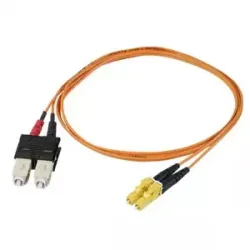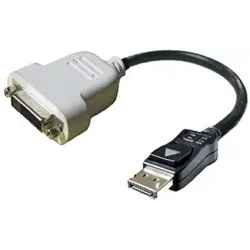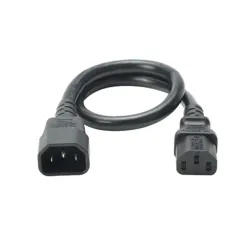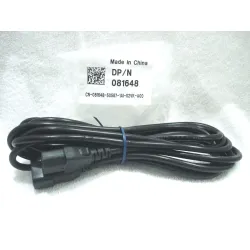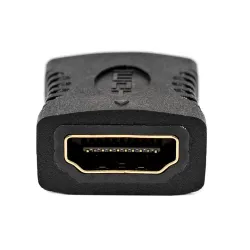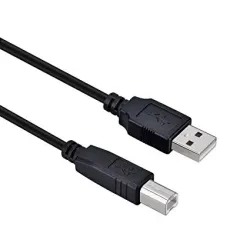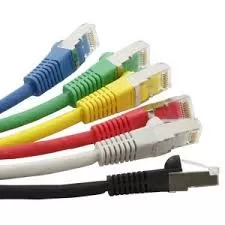 Server and Networking Cables
Server and Networking Cables
What are Server and Networking Cables
Server and networking cables are cables used to connect servers, switches, routers, and other networking devices in a computer network. They are designed to transmit data and information between these devices and provide a stable and reliable network connection.
There are different types of server and networking cables, including Ethernet, fiber optic, coaxial, and USB cables. Ethernet cables are commonly used for local area networks (LANs) and wide area networks (WANs), while fiber optic cables are used for long-distance transmission of data. Coaxial cables are commonly used in cable television networks, and USB cables are used to connect peripheral devices to computers.
The type of cable used in a network can impact the network's speed, reliability, and overall performance. Therefore, it's important to select the appropriate type of cable based on the network's needs and requirements. Additionally, proper cable management and installation practices should be followed to ensure optimal network performance and prevent downtime.
Types of networking cables and their uses
There are several types of networking cables, each with its own characteristics and intended uses. Here are some of the most common types of networking cables and their uses:
Ethernet Cable:
Ethernet cables are the most common type of networking cable used for wired LANs and WANs. They are typically used to connect devices like computers, switches, routers, and modems to a network. There are several categories of Ethernet cables, including Cat5, Cat5e, Cat6, and Cat7, with each category offering higher data transmission rates and better noise protection.
Fiber Optic Cable:
Fiber optic cables are used for long-distance transmission of data over a network. They use light to transmit data, making them faster and more reliable than copper cables. Fiber optic cables are commonly used in telecommunications, cable TV, and internet service provider networks.
Coaxial Cable:
Coaxial cables are used for cable TV, internet, and other broadband connections. They have a copper core surrounded by a layer of insulation, a braided metal shield, and a plastic or rubber outer jacket.
Twisted Pair Cable:
Twisted pair cables are a type of Ethernet cable that consists of pairs of copper wires twisted together. They are used for short- to medium-distance networking applications, such as in homes and small offices. Twisted pair cables can be shielded or unshielded, with shielded cables offering better protection against electromagnetic interference (EMI).
USB Cable:
USB cables are used to connect peripheral devices to computers, such as printers, cameras, and external hard drives. They are available in different versions, such as USB 1.1, USB 2.0, USB 3.0, and USB 4, each with different data transfer rates and capabilities.
The importance of using high-quality networking cables
Using high-quality networking cables is crucial for ensuring optimal network performance and avoiding potential problems such as data loss, network downtime, and security breaches. Here are some reasons why using high-quality networking cables is important:
Speed and reliability:
High-quality cables have better insulation, shielding, and connectors, which allow them to transmit data faster and more reliably than low-quality cables. This means that the network can operate at its maximum speed and with fewer errors, resulting in better network performance and user experience.
Signal integrity:
High-quality cables have better signal integrity, meaning they are less susceptible to electromagnetic interference (EMI) and crosstalk. This reduces the risk of data loss or corruption, ensuring that data is transmitted accurately and reliably.
Longevity:
High-quality cables are more durable and can withstand wear and tear better than low-quality cables. This means that they will last longer and require less maintenance and replacement, resulting in lower costs in the long run.
Security:
High-quality cables are less likely to be tampered with or hacked, reducing the risk of security breaches and data theft. This is especially important for sensitive or confidential data, such as financial or personal information.
Compatibility:
High-quality cables are more likely to be compatible with different devices and standards, ensuring that the network can support a wide range of applications and devices.
The Future of networking cables
The future of networking cables is likely to involve advancements in technology and new developments in materials and design. Here are some potential trends and developments to watch for in the future of networking cables:
Higher speeds:
As data demands continue to increase, there will be a need for networking cables that can support even higher speeds. This may involve the development of new materials and designs that can better handle higher frequencies and data rates.
Improved durability:
Future networking cables may be designed to be even more durable and resistant to wear and tear. This may involve the use of stronger materials or innovative designs that can withstand environmental factors such as temperature, moisture, and vibration.
More efficient power consumption:
As energy efficiency becomes more important, there may be a trend towards networking cables that require less power to operate. This could involve the use of new materials that conduct electricity more efficiently or the development of more energy-efficient network protocols.
Wireless networking:
While networking cables will likely continue to play an important role in wired networks, there may be a trend towards more wireless networking solutions. This could involve the development of new wireless networking technologies that can offer faster and more reliable connections than current wireless standards.
Integration with other technologies:
As networking becomes more integrated with other technologies, such as the Internet of Things (IoT) and cloud computing, networking cables may need to be designed to support these new applications. This could involve the development of new networking protocols and standards that can better handle the unique requirements of these emerging technologies.
The impact of networking cable quality on cybersecurity
The quality of networking cables can have a significant impact on cybersecurity. Here are some ways in which poor-quality networking cables can compromise network security:
Vulnerability to electromagnetic interference (EMI):
Poor-quality networking cables may not have adequate shielding, which can make them more vulnerable to EMI. This can result in data corruption or interception by unauthorized parties.
Data loss and corruption:
Poor-quality networking cables may be prone to data loss or corruption, which can compromise the integrity and confidentiality of sensitive information.
Greater susceptibility to hacking and cyber attacks:
Poor-quality cables may be more susceptible to hacking and cyber-attacks due to their vulnerability to EMI, data loss, and other issues.
Reduced network performance:
Poor-quality cables may not be able to support high-speed data transmission and may result in slow network performance. This can create security risks by leaving networks vulnerable to attacks due to latency and lack of real-time response.
Network downtime:
Poor-quality cables can lead to network downtime, which can result in lost productivity and revenue. This can also create security risks by leaving networks vulnerable to attacks during periods of inactivity.
The cables connected to a server depending on the specific setup and requirements of the server. However, some common cables that are often connected to a server include power cables, network cables (such as Ethernet cables), and storage cables (such as SATA or SAS cables). Power cables are necessary to provide electricity to the server, while network cables are used to connect the server to a network for communication purposes. Storage cables are used to connect hard drives or other storage devices to the server, allowing the server to store and retrieve data. Other cables that may be connected to a server include video cables (such as VGA or HDMI) for connecting to a monitor, or USB cables for connecting peripherals such as a keyboard or mouse.
The best cable for networking depends on the specific needs and requirements of the network. Currently, there are several types of networking cables commonly used, including Cat5e, Cat6, and Cat7 cables. Cat5e cables are the most common and affordable option for home networks and small businesses. They support speeds up to 1 Gbps and are suitable for distances up to 100 meters. Cat6 cables are an improved version of Cat5e cables and can support higher speeds of up to 10 Gbps, making them ideal for larger businesses and high-performance networks. Cat7 cables are the most advanced and expensive option, capable of supporting speeds up to 40 Gbps over a distance of up to 100 meters. They are typically used in data centers or other environments where high-speed and reliable connectivity is critical. Ultimately, the best cable for networking depends on the specific needs of the network, including the required speed, distance, and reliability.
Currently, the fastest network cable available is the Category 8 (Cat8) cable. It is designed to support speeds up to 40 Gbps over a distance of up to 30 meters. The Cat8 cable uses a shielded twisted pair (STP) design with a bandwidth of up to 2 GHz, which reduces crosstalk and electromagnetic interference, resulting in a more reliable and faster connection. However, it's important to note that the use of Cat8 cables requires specialized equipment that supports the standard, and they are typically used in data centers or other environments where high-speed and reliable connectivity is critical. For most home and small business networks, Cat5e or Cat6 cables are sufficient to provide fast and reliable connectivity.
The cable typically used to connect a router and server is an Ethernet cable. Ethernet cables are a type of networking cable that can transmit data over a wired connection. They come in different categories such as Cat5e, Cat6, and Cat7, each with varying speeds and distances. Ethernet cables typically have an RJ45 connector on each end, which is used to plug into the Ethernet ports on the router and server. The Ethernet cable is an essential component of a wired network, and it provides a reliable and stable connection between the router and server, allowing for data to be transferred quickly and efficiently.

-250x250w.gif)


